EYP 2: Health, Safety, Support & Care Routines for Young Children
VerifiedAdded on 2023/06/14
|36
|9380
|252
Project
AI Summary
This project focuses on the health and safety of babies and young children in early years settings, referencing legal requirements and guidelines such as the Early Years Foundation Stage (EYFS 2021), Health and Safety at Work Act 1974, Childcare Act 2006, COSHH 2002, RIDDOR 1995, and the Food Hygiene (England) Regulations 2006. It explains how these legislations inform day-to-day practices, emphasizing the importance of creating a safe and healthy environment for children. The project outlines specific procedures followed in early years settings to ensure child safety, including risk assessments and adherence to hygiene standards, and discusses the role of staff training in maintaining these standards. It also highlights the significance of security measures to protect children from harm and ensure their well-being within the childcare environment.
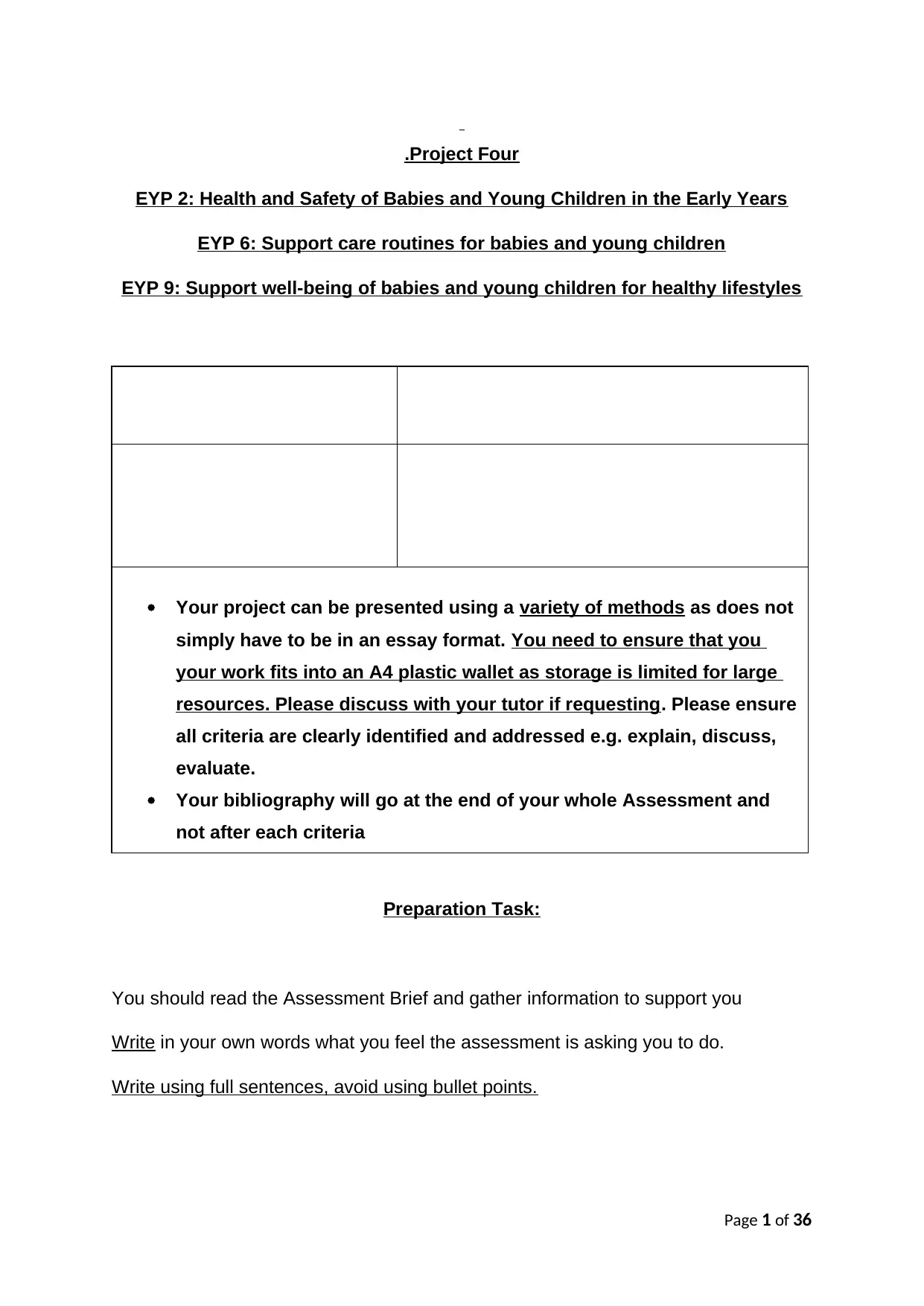
.Project Four
EYP 2: Health and Safety of Babies and Young Children in the Early Years
EYP 6: Support care routines for babies and young children
EYP 9: Support well-being of babies and young children for healthy lifestyles
Your project can be presented using a variety of methods as does not
simply have to be in an essay format. You need to ensure that you
your work fits into an A4 plastic wallet as storage is limited for large
resources. Please discuss with your tutor if requesting. Please ensure
all criteria are clearly identified and addressed e.g. explain, discuss,
evaluate.
Your bibliography will go at the end of your whole Assessment and
not after each criteria
Preparation Task:
You should read the Assessment Brief and gather information to support you
Write in your own words what you feel the assessment is asking you to do.
Write using full sentences, avoid using bullet points.
Page 1 of 36
EYP 2: Health and Safety of Babies and Young Children in the Early Years
EYP 6: Support care routines for babies and young children
EYP 9: Support well-being of babies and young children for healthy lifestyles
Your project can be presented using a variety of methods as does not
simply have to be in an essay format. You need to ensure that you
your work fits into an A4 plastic wallet as storage is limited for large
resources. Please discuss with your tutor if requesting. Please ensure
all criteria are clearly identified and addressed e.g. explain, discuss,
evaluate.
Your bibliography will go at the end of your whole Assessment and
not after each criteria
Preparation Task:
You should read the Assessment Brief and gather information to support you
Write in your own words what you feel the assessment is asking you to do.
Write using full sentences, avoid using bullet points.
Page 1 of 36
Paraphrase This Document
Need a fresh take? Get an instant paraphrase of this document with our AI Paraphraser
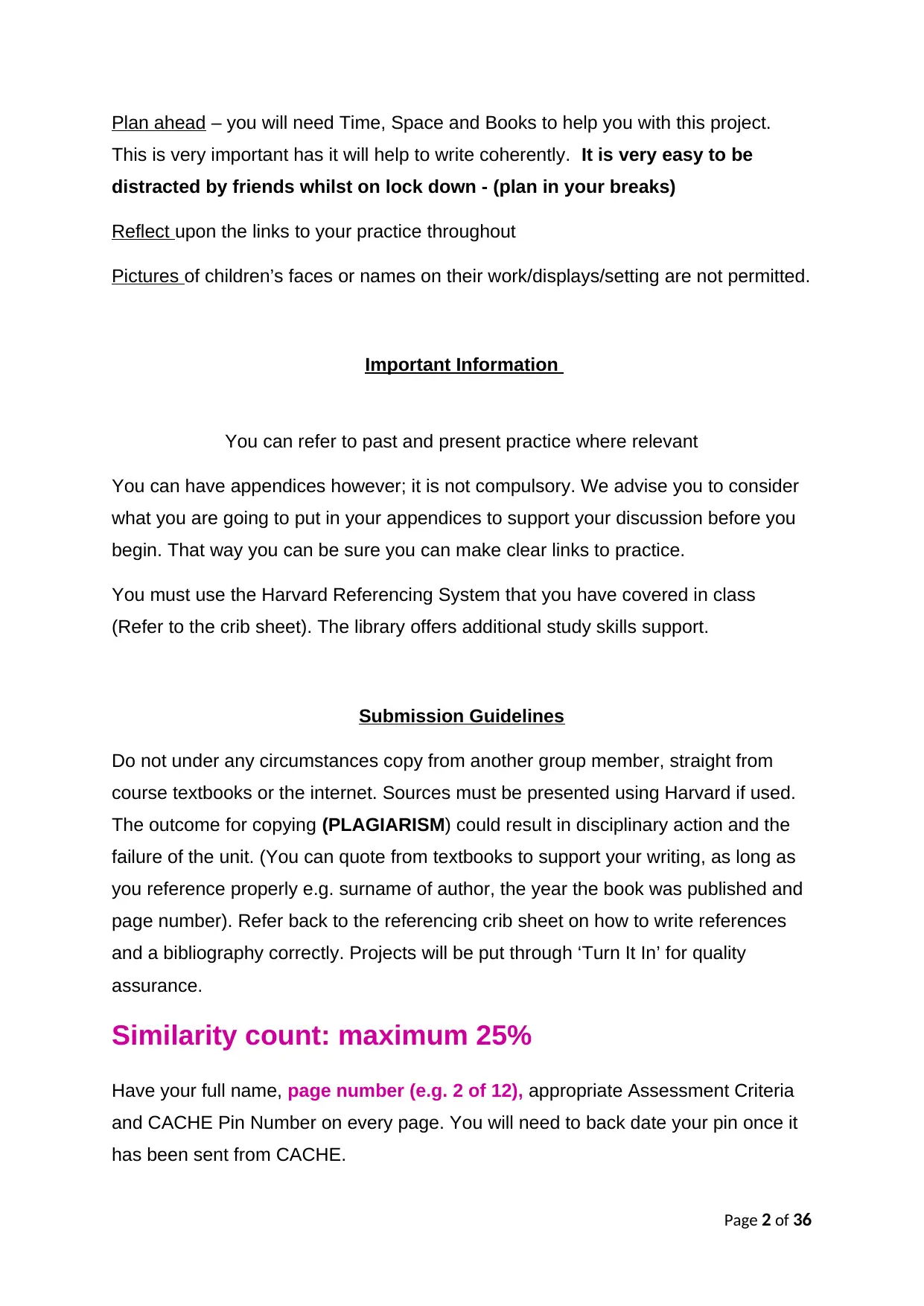
Plan ahead – you will need Time, Space and Books to help you with this project.
This is very important has it will help to write coherently. It is very easy to be
distracted by friends whilst on lock down - (plan in your breaks)
Reflect upon the links to your practice throughout
Pictures of children’s faces or names on their work/displays/setting are not permitted.
Important Information
You can refer to past and present practice where relevant
You can have appendices however; it is not compulsory. We advise you to consider
what you are going to put in your appendices to support your discussion before you
begin. That way you can be sure you can make clear links to practice.
You must use the Harvard Referencing System that you have covered in class
(Refer to the crib sheet). The library offers additional study skills support.
Submission Guidelines
Do not under any circumstances copy from another group member, straight from
course textbooks or the internet. Sources must be presented using Harvard if used.
The outcome for copying (PLAGIARISM) could result in disciplinary action and the
failure of the unit. (You can quote from textbooks to support your writing, as long as
you reference properly e.g. surname of author, the year the book was published and
page number). Refer back to the referencing crib sheet on how to write references
and a bibliography correctly. Projects will be put through ‘Turn It In’ for quality
assurance.
Similarity count: maximum 25%
Have your full name, page number (e.g. 2 of 12), appropriate Assessment Criteria
and CACHE Pin Number on every page. You will need to back date your pin once it
has been sent from CACHE.
Page 2 of 36
This is very important has it will help to write coherently. It is very easy to be
distracted by friends whilst on lock down - (plan in your breaks)
Reflect upon the links to your practice throughout
Pictures of children’s faces or names on their work/displays/setting are not permitted.
Important Information
You can refer to past and present practice where relevant
You can have appendices however; it is not compulsory. We advise you to consider
what you are going to put in your appendices to support your discussion before you
begin. That way you can be sure you can make clear links to practice.
You must use the Harvard Referencing System that you have covered in class
(Refer to the crib sheet). The library offers additional study skills support.
Submission Guidelines
Do not under any circumstances copy from another group member, straight from
course textbooks or the internet. Sources must be presented using Harvard if used.
The outcome for copying (PLAGIARISM) could result in disciplinary action and the
failure of the unit. (You can quote from textbooks to support your writing, as long as
you reference properly e.g. surname of author, the year the book was published and
page number). Refer back to the referencing crib sheet on how to write references
and a bibliography correctly. Projects will be put through ‘Turn It In’ for quality
assurance.
Similarity count: maximum 25%
Have your full name, page number (e.g. 2 of 12), appropriate Assessment Criteria
and CACHE Pin Number on every page. You will need to back date your pin once it
has been sent from CACHE.
Page 2 of 36
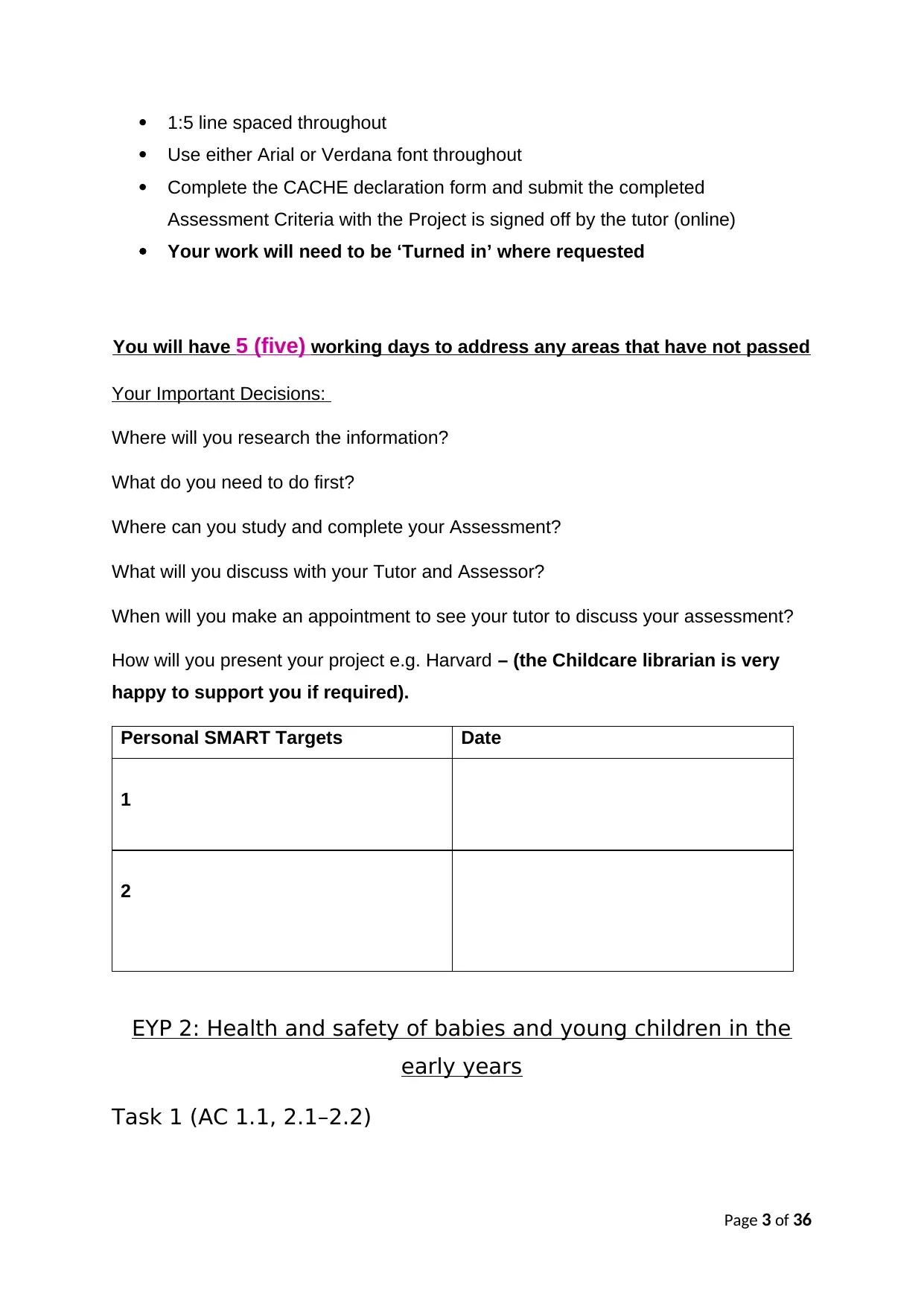
1:5 line spaced throughout
Use either Arial or Verdana font throughout
Complete the CACHE declaration form and submit the completed
Assessment Criteria with the Project is signed off by the tutor (online)
Your work will need to be ‘Turned in’ where requested
You will have 5 (five) working days to address any areas that have not passed
Your Important Decisions:
Where will you research the information?
What do you need to do first?
Where can you study and complete your Assessment?
What will you discuss with your Tutor and Assessor?
When will you make an appointment to see your tutor to discuss your assessment?
How will you present your project e.g. Harvard – (the Childcare librarian is very
happy to support you if required).
Personal SMART Targets Date
1
2
EYP 2: Health and safety of babies and young children in the
early years
Task 1 (AC 1.1, 2.1–2.2)
Page 3 of 36
Use either Arial or Verdana font throughout
Complete the CACHE declaration form and submit the completed
Assessment Criteria with the Project is signed off by the tutor (online)
Your work will need to be ‘Turned in’ where requested
You will have 5 (five) working days to address any areas that have not passed
Your Important Decisions:
Where will you research the information?
What do you need to do first?
Where can you study and complete your Assessment?
What will you discuss with your Tutor and Assessor?
When will you make an appointment to see your tutor to discuss your assessment?
How will you present your project e.g. Harvard – (the Childcare librarian is very
happy to support you if required).
Personal SMART Targets Date
1
2
EYP 2: Health and safety of babies and young children in the
early years
Task 1 (AC 1.1, 2.1–2.2)
Page 3 of 36
⊘ This is a preview!⊘
Do you want full access?
Subscribe today to unlock all pages.

Trusted by 1+ million students worldwide
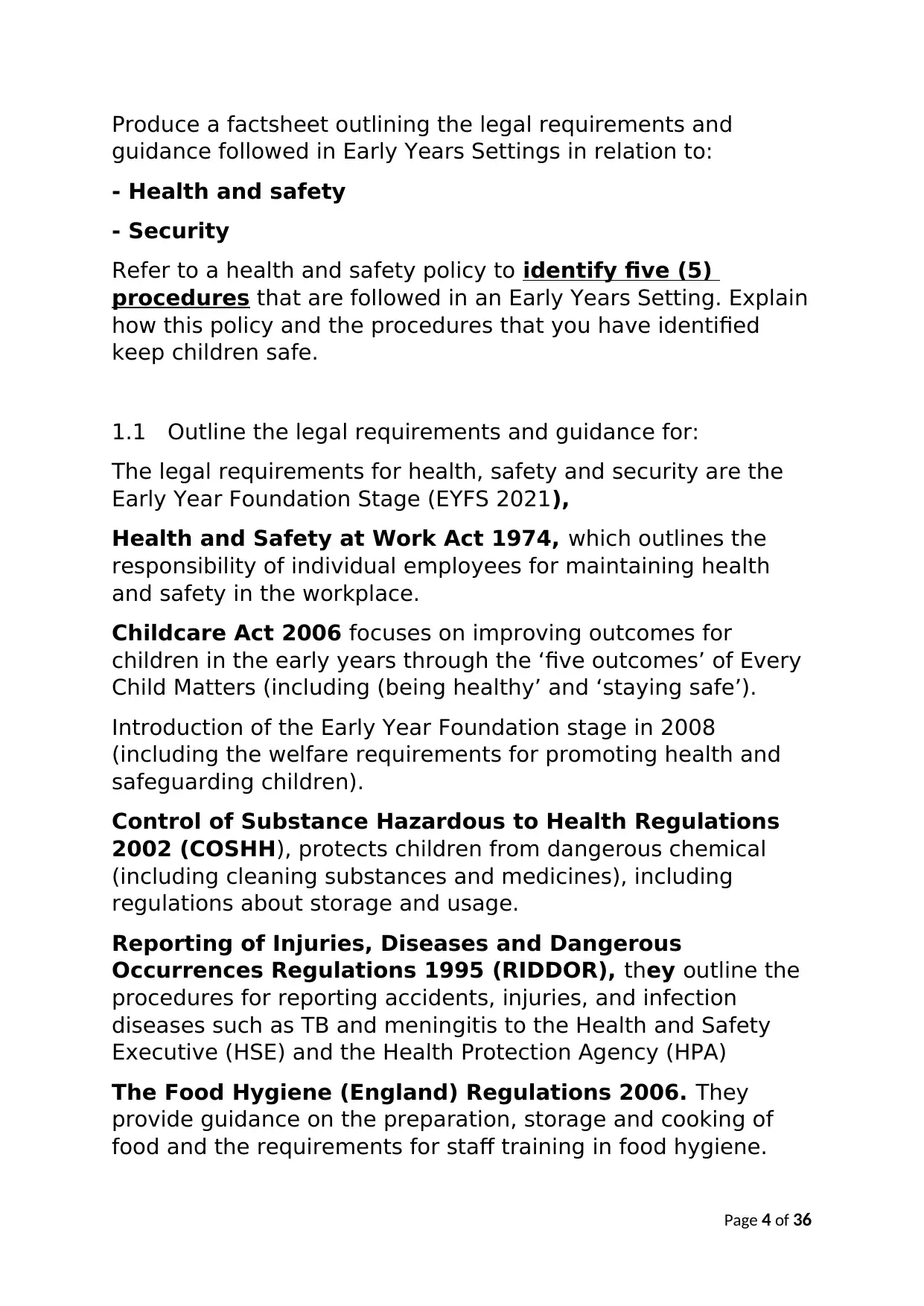
Produce a factsheet outlining the legal requirements and
guidance followed in Early Years Settings in relation to:
- Health and safety
- Security
Refer to a health and safety policy to identify five (5)
procedures that are followed in an Early Years Setting. Explain
how this policy and the procedures that you have identified
keep children safe.
1.1 Outline the legal requirements and guidance for:
The legal requirements for health, safety and security are the
Early Year Foundation Stage (EYFS 2021),
Health and Safety at Work Act 1974, which outlines the
responsibility of individual employees for maintaining health
and safety in the workplace.
Childcare Act 2006 focuses on improving outcomes for
children in the early years through the ‘five outcomes’ of Every
Child Matters (including (being healthy’ and ‘staying safe’).
Introduction of the Early Year Foundation stage in 2008
(including the welfare requirements for promoting health and
safeguarding children).
Control of Substance Hazardous to Health Regulations
2002 (COSHH), protects children from dangerous chemical
(including cleaning substances and medicines), including
regulations about storage and usage.
Reporting of Injuries, Diseases and Dangerous
Occurrences Regulations 1995 (RIDDOR), they outline the
procedures for reporting accidents, injuries, and infection
diseases such as TB and meningitis to the Health and Safety
Executive (HSE) and the Health Protection Agency (HPA)
The Food Hygiene (England) Regulations 2006. They
provide guidance on the preparation, storage and cooking of
food and the requirements for staff training in food hygiene.
Page 4 of 36
guidance followed in Early Years Settings in relation to:
- Health and safety
- Security
Refer to a health and safety policy to identify five (5)
procedures that are followed in an Early Years Setting. Explain
how this policy and the procedures that you have identified
keep children safe.
1.1 Outline the legal requirements and guidance for:
The legal requirements for health, safety and security are the
Early Year Foundation Stage (EYFS 2021),
Health and Safety at Work Act 1974, which outlines the
responsibility of individual employees for maintaining health
and safety in the workplace.
Childcare Act 2006 focuses on improving outcomes for
children in the early years through the ‘five outcomes’ of Every
Child Matters (including (being healthy’ and ‘staying safe’).
Introduction of the Early Year Foundation stage in 2008
(including the welfare requirements for promoting health and
safeguarding children).
Control of Substance Hazardous to Health Regulations
2002 (COSHH), protects children from dangerous chemical
(including cleaning substances and medicines), including
regulations about storage and usage.
Reporting of Injuries, Diseases and Dangerous
Occurrences Regulations 1995 (RIDDOR), they outline the
procedures for reporting accidents, injuries, and infection
diseases such as TB and meningitis to the Health and Safety
Executive (HSE) and the Health Protection Agency (HPA)
The Food Hygiene (England) Regulations 2006. They
provide guidance on the preparation, storage and cooking of
food and the requirements for staff training in food hygiene.
Page 4 of 36
Paraphrase This Document
Need a fresh take? Get an instant paraphrase of this document with our AI Paraphraser
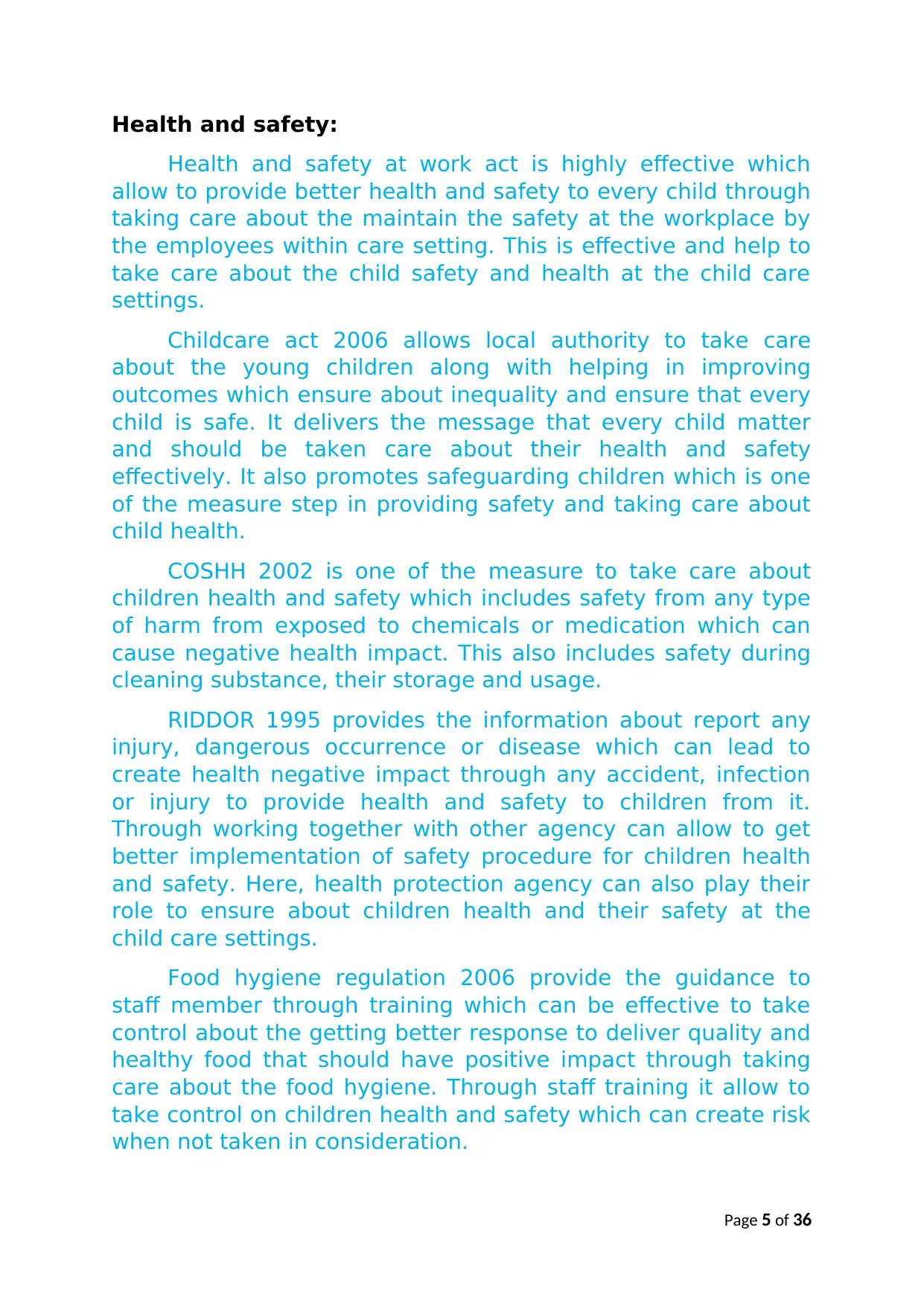
Health and safety:
Health and safety at work act is highly effective which
allow to provide better health and safety to every child through
taking care about the maintain the safety at the workplace by
the employees within care setting. This is effective and help to
take care about the child safety and health at the child care
settings.
Childcare act 2006 allows local authority to take care
about the young children along with helping in improving
outcomes which ensure about inequality and ensure that every
child is safe. It delivers the message that every child matter
and should be taken care about their health and safety
effectively. It also promotes safeguarding children which is one
of the measure step in providing safety and taking care about
child health.
COSHH 2002 is one of the measure to take care about
children health and safety which includes safety from any type
of harm from exposed to chemicals or medication which can
cause negative health impact. This also includes safety during
cleaning substance, their storage and usage.
RIDDOR 1995 provides the information about report any
injury, dangerous occurrence or disease which can lead to
create health negative impact through any accident, infection
or injury to provide health and safety to children from it.
Through working together with other agency can allow to get
better implementation of safety procedure for children health
and safety. Here, health protection agency can also play their
role to ensure about children health and their safety at the
child care settings.
Food hygiene regulation 2006 provide the guidance to
staff member through training which can be effective to take
control about the getting better response to deliver quality and
healthy food that should have positive impact through taking
care about the food hygiene. Through staff training it allow to
take control on children health and safety which can create risk
when not taken in consideration.
Page 5 of 36
Health and safety at work act is highly effective which
allow to provide better health and safety to every child through
taking care about the maintain the safety at the workplace by
the employees within care setting. This is effective and help to
take care about the child safety and health at the child care
settings.
Childcare act 2006 allows local authority to take care
about the young children along with helping in improving
outcomes which ensure about inequality and ensure that every
child is safe. It delivers the message that every child matter
and should be taken care about their health and safety
effectively. It also promotes safeguarding children which is one
of the measure step in providing safety and taking care about
child health.
COSHH 2002 is one of the measure to take care about
children health and safety which includes safety from any type
of harm from exposed to chemicals or medication which can
cause negative health impact. This also includes safety during
cleaning substance, their storage and usage.
RIDDOR 1995 provides the information about report any
injury, dangerous occurrence or disease which can lead to
create health negative impact through any accident, infection
or injury to provide health and safety to children from it.
Through working together with other agency can allow to get
better implementation of safety procedure for children health
and safety. Here, health protection agency can also play their
role to ensure about children health and their safety at the
child care settings.
Food hygiene regulation 2006 provide the guidance to
staff member through training which can be effective to take
control about the getting better response to deliver quality and
healthy food that should have positive impact through taking
care about the food hygiene. Through staff training it allow to
take control on children health and safety which can create risk
when not taken in consideration.
Page 5 of 36

Security:
Through Health and safety at work act 1974 policy allows
to take care about children health which is effective in delivery
security for children health that is directly linked to their quality
life and care about their better security from getting sick or ill
and cause risk of worsening of health at the child care settings.
Childcare act 2006 provides security to children to stay
safe which is one outcomes from the five outcomes. This
enhance and ensure about every child security to get safe at
the workplace or childcare setting which allow to live life
effective and help in proper growth and development. This also
include being healthy along with staying safe. through this
policy, child is safe at their early stage of life. It also promotes
safeguarding which is one of the best way to take care about
the security of any individual.
COSHH 2002 implies about take care of children from
getting any harm and should ensure about proper security from
getting any type of physical harm at the childcare setting.
There is need to ensure about the security from getting hurt or
impacted due to dangerous chemicals which may include
medicines or cleaning substance.
RIDDOR 1995 outline some procedure which are effective
in providing security from worsening of health after getting any
accident, infection or injury like any accident. Here, external
health protection agency plays their role in providing security
and taking care about follow up of the legal procedure which
can help to reduce the risk of worsening of condition.
Food hygiene regulation 2006 refer to the security from
any type of infection or getting ill due to uptake of unhygienic
food and not well processed food. This also provide safety to
children through providing training about storage, preparation
along with cooking which can be there regarding food that can
allow to take care about the safety and security from getting
any type of negative health impact related with food.
Page 6 of 36
Through Health and safety at work act 1974 policy allows
to take care about children health which is effective in delivery
security for children health that is directly linked to their quality
life and care about their better security from getting sick or ill
and cause risk of worsening of health at the child care settings.
Childcare act 2006 provides security to children to stay
safe which is one outcomes from the five outcomes. This
enhance and ensure about every child security to get safe at
the workplace or childcare setting which allow to live life
effective and help in proper growth and development. This also
include being healthy along with staying safe. through this
policy, child is safe at their early stage of life. It also promotes
safeguarding which is one of the best way to take care about
the security of any individual.
COSHH 2002 implies about take care of children from
getting any harm and should ensure about proper security from
getting any type of physical harm at the childcare setting.
There is need to ensure about the security from getting hurt or
impacted due to dangerous chemicals which may include
medicines or cleaning substance.
RIDDOR 1995 outline some procedure which are effective
in providing security from worsening of health after getting any
accident, infection or injury like any accident. Here, external
health protection agency plays their role in providing security
and taking care about follow up of the legal procedure which
can help to reduce the risk of worsening of condition.
Food hygiene regulation 2006 refer to the security from
any type of infection or getting ill due to uptake of unhygienic
food and not well processed food. This also provide safety to
children through providing training about storage, preparation
along with cooking which can be there regarding food that can
allow to take care about the safety and security from getting
any type of negative health impact related with food.
Page 6 of 36
⊘ This is a preview!⊘
Do you want full access?
Subscribe today to unlock all pages.

Trusted by 1+ million students worldwide
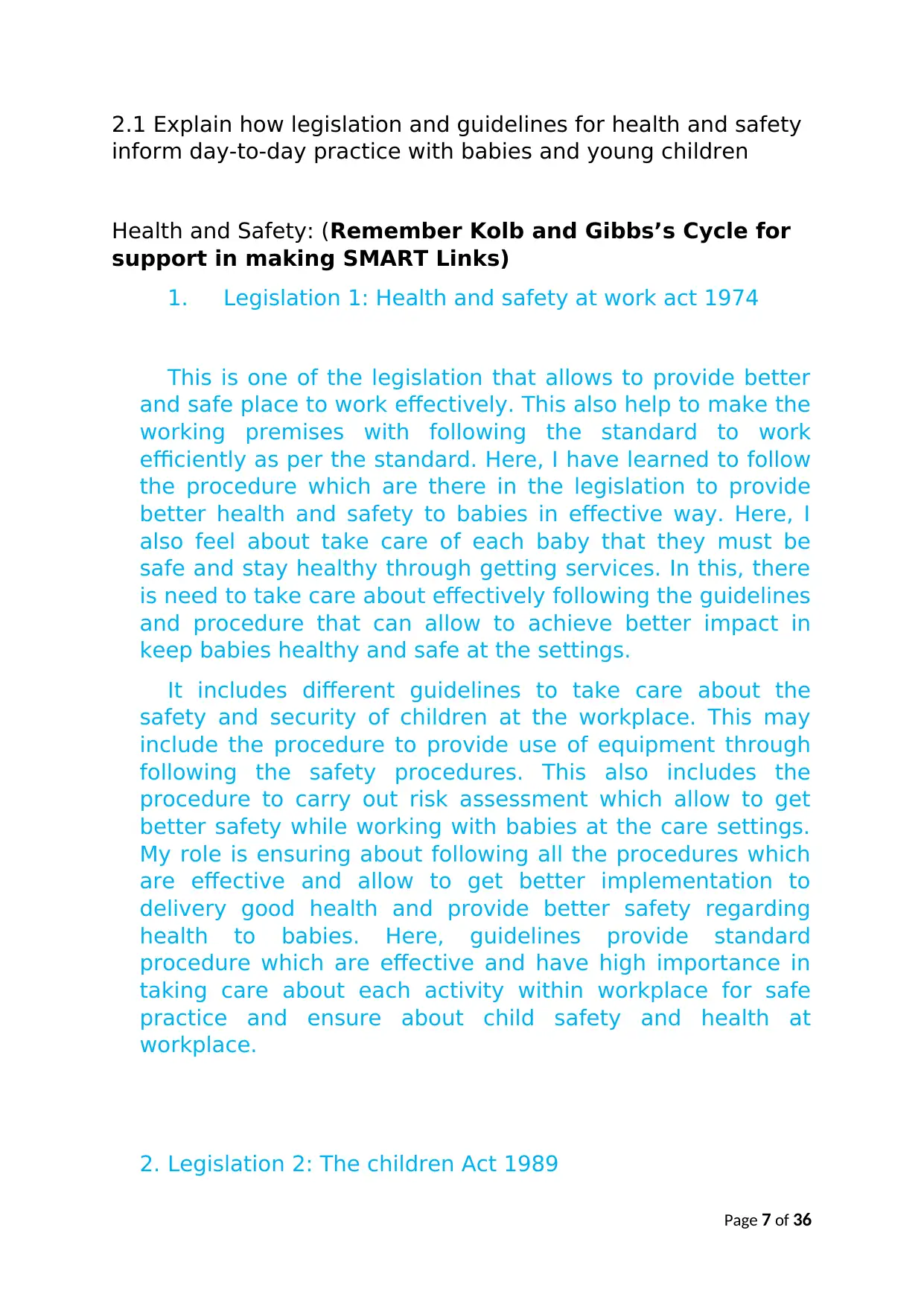
2.1 Explain how legislation and guidelines for health and safety
inform day-to-day practice with babies and young children
Health and Safety: (Remember Kolb and Gibbs’s Cycle for
support in making SMART Links)
1. Legislation 1: Health and safety at work act 1974
This is one of the legislation that allows to provide better
and safe place to work effectively. This also help to make the
working premises with following the standard to work
efficiently as per the standard. Here, I have learned to follow
the procedure which are there in the legislation to provide
better health and safety to babies in effective way. Here, I
also feel about take care of each baby that they must be
safe and stay healthy through getting services. In this, there
is need to take care about effectively following the guidelines
and procedure that can allow to achieve better impact in
keep babies healthy and safe at the settings.
It includes different guidelines to take care about the
safety and security of children at the workplace. This may
include the procedure to provide use of equipment through
following the safety procedures. This also includes the
procedure to carry out risk assessment which allow to get
better safety while working with babies at the care settings.
My role is ensuring about following all the procedures which
are effective and allow to get better implementation to
delivery good health and provide better safety regarding
health to babies. Here, guidelines provide standard
procedure which are effective and have high importance in
taking care about each activity within workplace for safe
practice and ensure about child safety and health at
workplace.
2. Legislation 2: The children Act 1989
Page 7 of 36
inform day-to-day practice with babies and young children
Health and Safety: (Remember Kolb and Gibbs’s Cycle for
support in making SMART Links)
1. Legislation 1: Health and safety at work act 1974
This is one of the legislation that allows to provide better
and safe place to work effectively. This also help to make the
working premises with following the standard to work
efficiently as per the standard. Here, I have learned to follow
the procedure which are there in the legislation to provide
better health and safety to babies in effective way. Here, I
also feel about take care of each baby that they must be
safe and stay healthy through getting services. In this, there
is need to take care about effectively following the guidelines
and procedure that can allow to achieve better impact in
keep babies healthy and safe at the settings.
It includes different guidelines to take care about the
safety and security of children at the workplace. This may
include the procedure to provide use of equipment through
following the safety procedures. This also includes the
procedure to carry out risk assessment which allow to get
better safety while working with babies at the care settings.
My role is ensuring about following all the procedures which
are effective and allow to get better implementation to
delivery good health and provide better safety regarding
health to babies. Here, guidelines provide standard
procedure which are effective and have high importance in
taking care about each activity within workplace for safe
practice and ensure about child safety and health at
workplace.
2. Legislation 2: The children Act 1989
Page 7 of 36
Paraphrase This Document
Need a fresh take? Get an instant paraphrase of this document with our AI Paraphraser
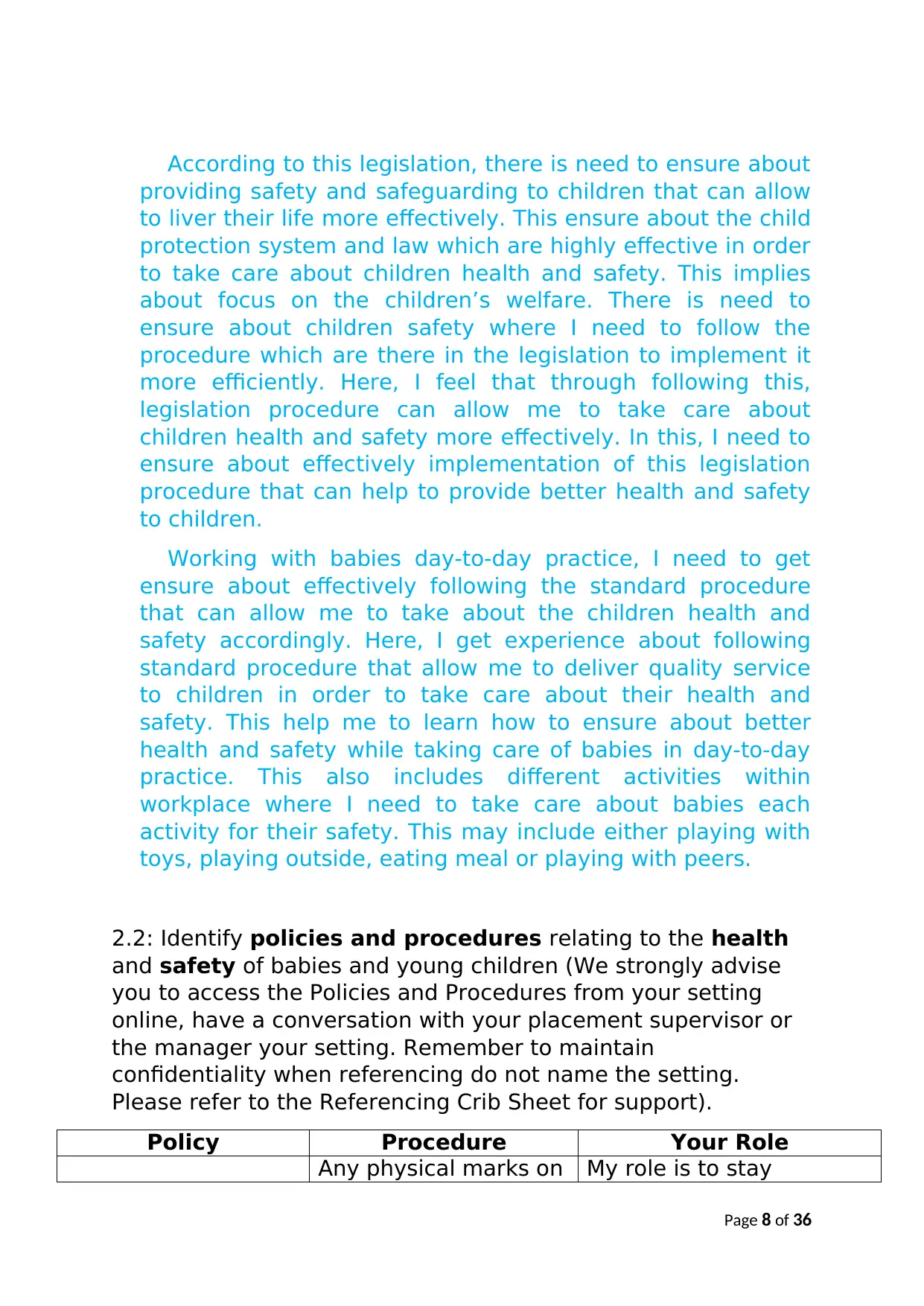
According to this legislation, there is need to ensure about
providing safety and safeguarding to children that can allow
to liver their life more effectively. This ensure about the child
protection system and law which are highly effective in order
to take care about children health and safety. This implies
about focus on the children’s welfare. There is need to
ensure about children safety where I need to follow the
procedure which are there in the legislation to implement it
more efficiently. Here, I feel that through following this,
legislation procedure can allow me to take care about
children health and safety more effectively. In this, I need to
ensure about effectively implementation of this legislation
procedure that can help to provide better health and safety
to children.
Working with babies day-to-day practice, I need to get
ensure about effectively following the standard procedure
that can allow me to take about the children health and
safety accordingly. Here, I get experience about following
standard procedure that allow me to deliver quality service
to children in order to take care about their health and
safety. This help me to learn how to ensure about better
health and safety while taking care of babies in day-to-day
practice. This also includes different activities within
workplace where I need to take care about babies each
activity for their safety. This may include either playing with
toys, playing outside, eating meal or playing with peers.
2.2: Identify policies and procedures relating to the health
and safety of babies and young children (We strongly advise
you to access the Policies and Procedures from your setting
online, have a conversation with your placement supervisor or
the manager your setting. Remember to maintain
confidentiality when referencing do not name the setting.
Please refer to the Referencing Crib Sheet for support).
Policy Procedure Your Role
Any physical marks on My role is to stay
Page 8 of 36
providing safety and safeguarding to children that can allow
to liver their life more effectively. This ensure about the child
protection system and law which are highly effective in order
to take care about children health and safety. This implies
about focus on the children’s welfare. There is need to
ensure about children safety where I need to follow the
procedure which are there in the legislation to implement it
more efficiently. Here, I feel that through following this,
legislation procedure can allow me to take care about
children health and safety more effectively. In this, I need to
ensure about effectively implementation of this legislation
procedure that can help to provide better health and safety
to children.
Working with babies day-to-day practice, I need to get
ensure about effectively following the standard procedure
that can allow me to take about the children health and
safety accordingly. Here, I get experience about following
standard procedure that allow me to deliver quality service
to children in order to take care about their health and
safety. This help me to learn how to ensure about better
health and safety while taking care of babies in day-to-day
practice. This also includes different activities within
workplace where I need to take care about babies each
activity for their safety. This may include either playing with
toys, playing outside, eating meal or playing with peers.
2.2: Identify policies and procedures relating to the health
and safety of babies and young children (We strongly advise
you to access the Policies and Procedures from your setting
online, have a conversation with your placement supervisor or
the manager your setting. Remember to maintain
confidentiality when referencing do not name the setting.
Please refer to the Referencing Crib Sheet for support).
Policy Procedure Your Role
Any physical marks on My role is to stay
Page 8 of 36
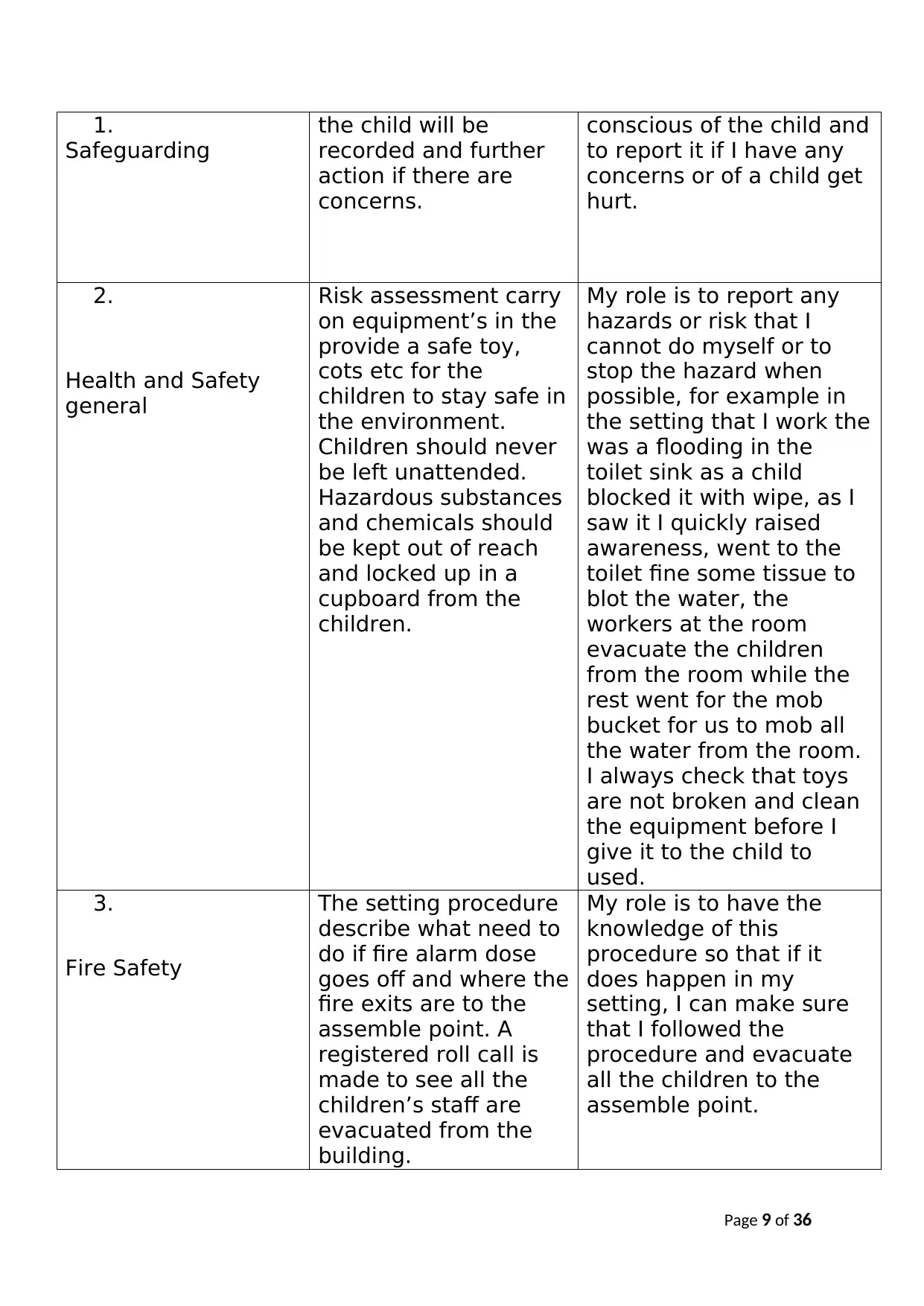
1.
Safeguarding
the child will be
recorded and further
action if there are
concerns.
conscious of the child and
to report it if I have any
concerns or of a child get
hurt.
2.
Health and Safety
general
Risk assessment carry
on equipment’s in the
provide a safe toy,
cots etc for the
children to stay safe in
the environment.
Children should never
be left unattended.
Hazardous substances
and chemicals should
be kept out of reach
and locked up in a
cupboard from the
children.
My role is to report any
hazards or risk that I
cannot do myself or to
stop the hazard when
possible, for example in
the setting that I work the
was a flooding in the
toilet sink as a child
blocked it with wipe, as I
saw it I quickly raised
awareness, went to the
toilet fine some tissue to
blot the water, the
workers at the room
evacuate the children
from the room while the
rest went for the mob
bucket for us to mob all
the water from the room.
I always check that toys
are not broken and clean
the equipment before I
give it to the child to
used.
3.
Fire Safety
The setting procedure
describe what need to
do if fire alarm dose
goes off and where the
fire exits are to the
assemble point. A
registered roll call is
made to see all the
children’s staff are
evacuated from the
building.
My role is to have the
knowledge of this
procedure so that if it
does happen in my
setting, I can make sure
that I followed the
procedure and evacuate
all the children to the
assemble point.
Page 9 of 36
Safeguarding
the child will be
recorded and further
action if there are
concerns.
conscious of the child and
to report it if I have any
concerns or of a child get
hurt.
2.
Health and Safety
general
Risk assessment carry
on equipment’s in the
provide a safe toy,
cots etc for the
children to stay safe in
the environment.
Children should never
be left unattended.
Hazardous substances
and chemicals should
be kept out of reach
and locked up in a
cupboard from the
children.
My role is to report any
hazards or risk that I
cannot do myself or to
stop the hazard when
possible, for example in
the setting that I work the
was a flooding in the
toilet sink as a child
blocked it with wipe, as I
saw it I quickly raised
awareness, went to the
toilet fine some tissue to
blot the water, the
workers at the room
evacuate the children
from the room while the
rest went for the mob
bucket for us to mob all
the water from the room.
I always check that toys
are not broken and clean
the equipment before I
give it to the child to
used.
3.
Fire Safety
The setting procedure
describe what need to
do if fire alarm dose
goes off and where the
fire exits are to the
assemble point. A
registered roll call is
made to see all the
children’s staff are
evacuated from the
building.
My role is to have the
knowledge of this
procedure so that if it
does happen in my
setting, I can make sure
that I followed the
procedure and evacuate
all the children to the
assemble point.
Page 9 of 36
⊘ This is a preview!⊘
Do you want full access?
Subscribe today to unlock all pages.

Trusted by 1+ million students worldwide
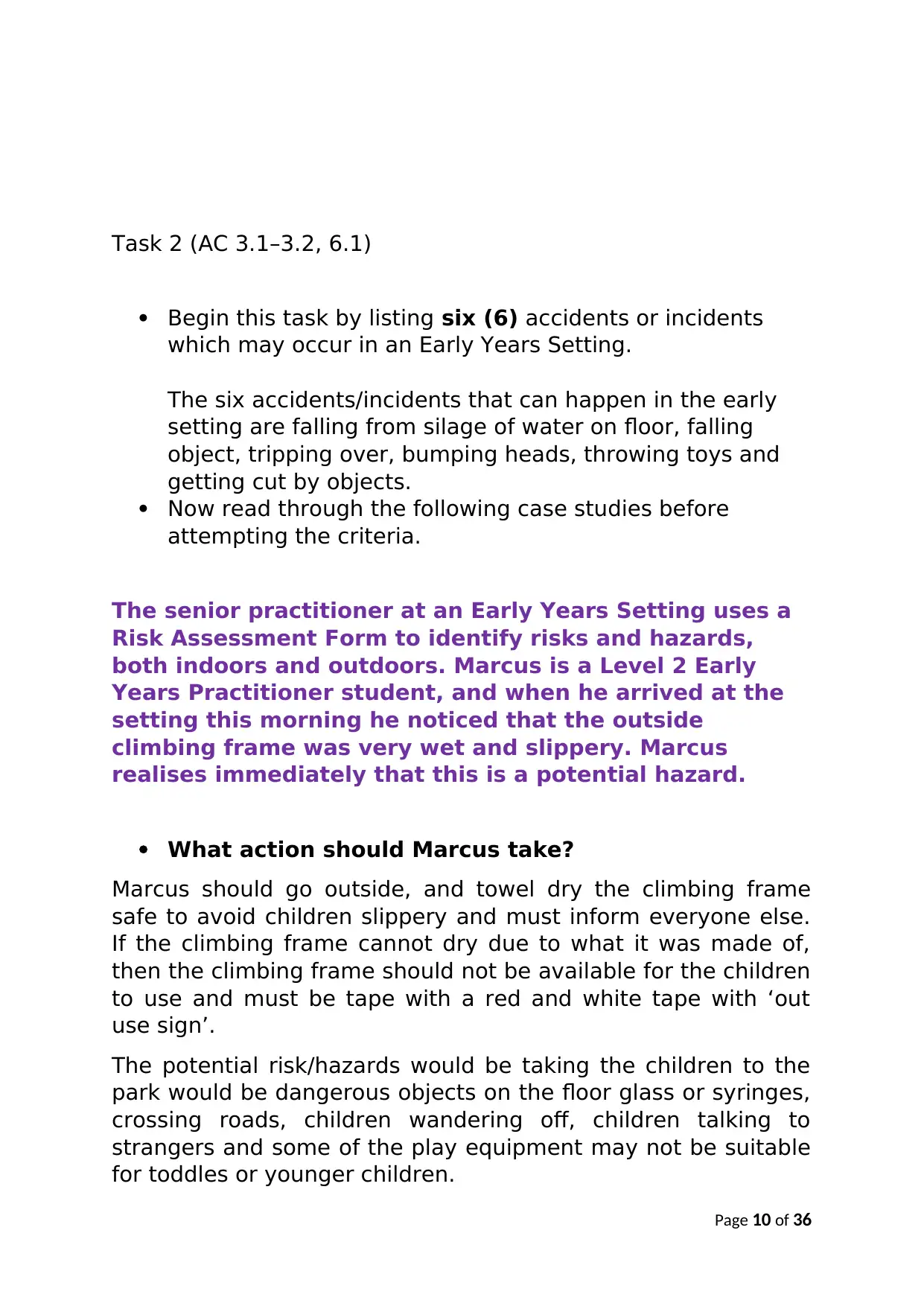
Task 2 (AC 3.1–3.2, 6.1)
Begin this task by listing six (6) accidents or incidents
which may occur in an Early Years Setting.
The six accidents/incidents that can happen in the early
setting are falling from silage of water on floor, falling
object, tripping over, bumping heads, throwing toys and
getting cut by objects.
Now read through the following case studies before
attempting the criteria.
The senior practitioner at an Early Years Setting uses a
Risk Assessment Form to identify risks and hazards,
both indoors and outdoors. Marcus is a Level 2 Early
Years Practitioner student, and when he arrived at the
setting this morning he noticed that the outside
climbing frame was very wet and slippery. Marcus
realises immediately that this is a potential hazard.
What action should Marcus take?
Marcus should go outside, and towel dry the climbing frame
safe to avoid children slippery and must inform everyone else.
If the climbing frame cannot dry due to what it was made of,
then the climbing frame should not be available for the children
to use and must be tape with a red and white tape with ‘out
use sign’.
The potential risk/hazards would be taking the children to the
park would be dangerous objects on the floor glass or syringes,
crossing roads, children wandering off, children talking to
strangers and some of the play equipment may not be suitable
for toddles or younger children.
Page 10 of 36
Begin this task by listing six (6) accidents or incidents
which may occur in an Early Years Setting.
The six accidents/incidents that can happen in the early
setting are falling from silage of water on floor, falling
object, tripping over, bumping heads, throwing toys and
getting cut by objects.
Now read through the following case studies before
attempting the criteria.
The senior practitioner at an Early Years Setting uses a
Risk Assessment Form to identify risks and hazards,
both indoors and outdoors. Marcus is a Level 2 Early
Years Practitioner student, and when he arrived at the
setting this morning he noticed that the outside
climbing frame was very wet and slippery. Marcus
realises immediately that this is a potential hazard.
What action should Marcus take?
Marcus should go outside, and towel dry the climbing frame
safe to avoid children slippery and must inform everyone else.
If the climbing frame cannot dry due to what it was made of,
then the climbing frame should not be available for the children
to use and must be tape with a red and white tape with ‘out
use sign’.
The potential risk/hazards would be taking the children to the
park would be dangerous objects on the floor glass or syringes,
crossing roads, children wandering off, children talking to
strangers and some of the play equipment may not be suitable
for toddles or younger children.
Page 10 of 36
Paraphrase This Document
Need a fresh take? Get an instant paraphrase of this document with our AI Paraphraser
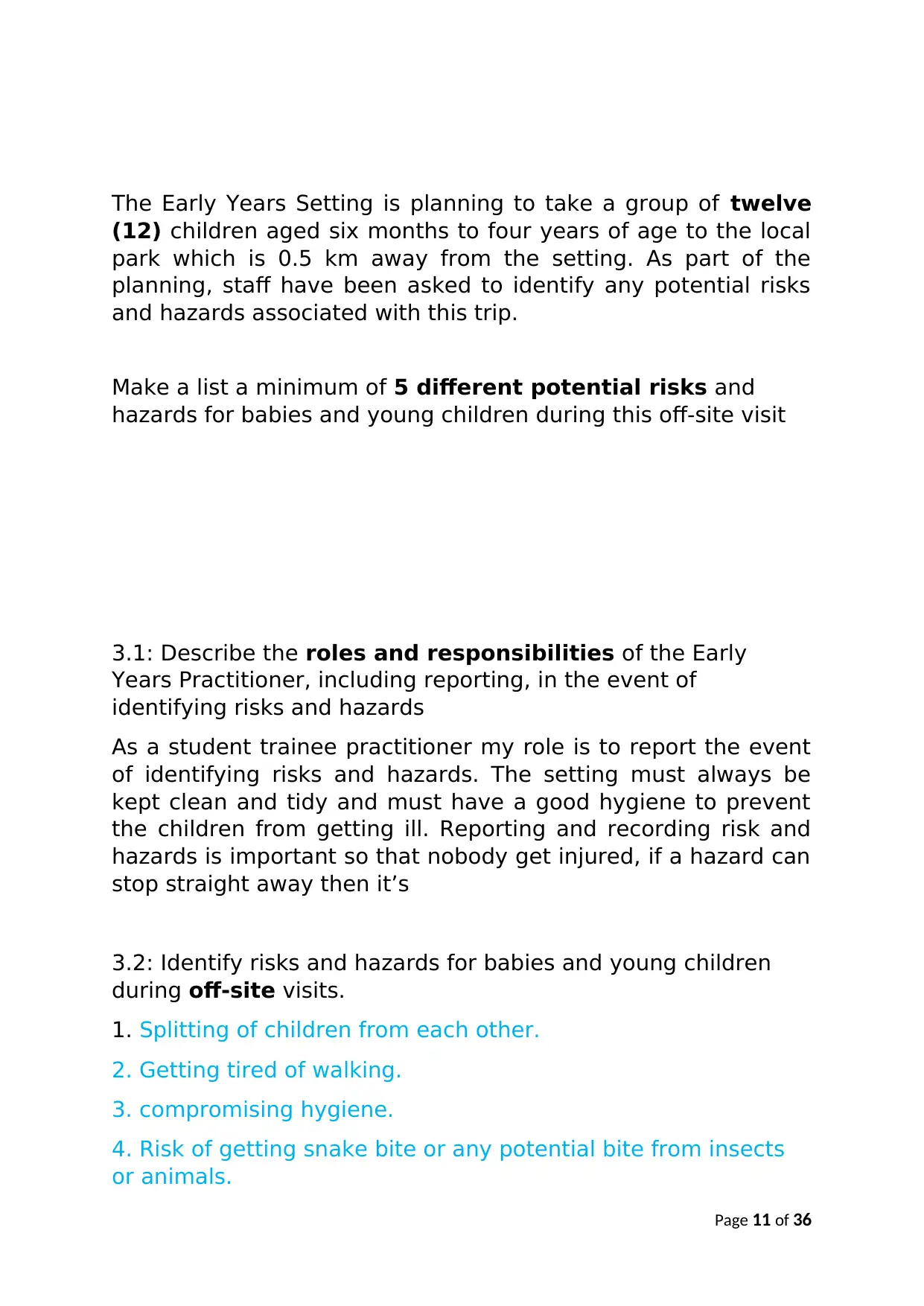
The Early Years Setting is planning to take a group of twelve
(12) children aged six months to four years of age to the local
park which is 0.5 km away from the setting. As part of the
planning, staff have been asked to identify any potential risks
and hazards associated with this trip.
Make a list a minimum of 5 different potential risks and
hazards for babies and young children during this off-site visit
3.1: Describe the roles and responsibilities of the Early
Years Practitioner, including reporting, in the event of
identifying risks and hazards
As a student trainee practitioner my role is to report the event
of identifying risks and hazards. The setting must always be
kept clean and tidy and must have a good hygiene to prevent
the children from getting ill. Reporting and recording risk and
hazards is important so that nobody get injured, if a hazard can
stop straight away then it’s
3.2: Identify risks and hazards for babies and young children
during off-site visits.
1. Splitting of children from each other.
2. Getting tired of walking.
3. compromising hygiene.
4. Risk of getting snake bite or any potential bite from insects
or animals.
Page 11 of 36
(12) children aged six months to four years of age to the local
park which is 0.5 km away from the setting. As part of the
planning, staff have been asked to identify any potential risks
and hazards associated with this trip.
Make a list a minimum of 5 different potential risks and
hazards for babies and young children during this off-site visit
3.1: Describe the roles and responsibilities of the Early
Years Practitioner, including reporting, in the event of
identifying risks and hazards
As a student trainee practitioner my role is to report the event
of identifying risks and hazards. The setting must always be
kept clean and tidy and must have a good hygiene to prevent
the children from getting ill. Reporting and recording risk and
hazards is important so that nobody get injured, if a hazard can
stop straight away then it’s
3.2: Identify risks and hazards for babies and young children
during off-site visits.
1. Splitting of children from each other.
2. Getting tired of walking.
3. compromising hygiene.
4. Risk of getting snake bite or any potential bite from insects
or animals.
Page 11 of 36
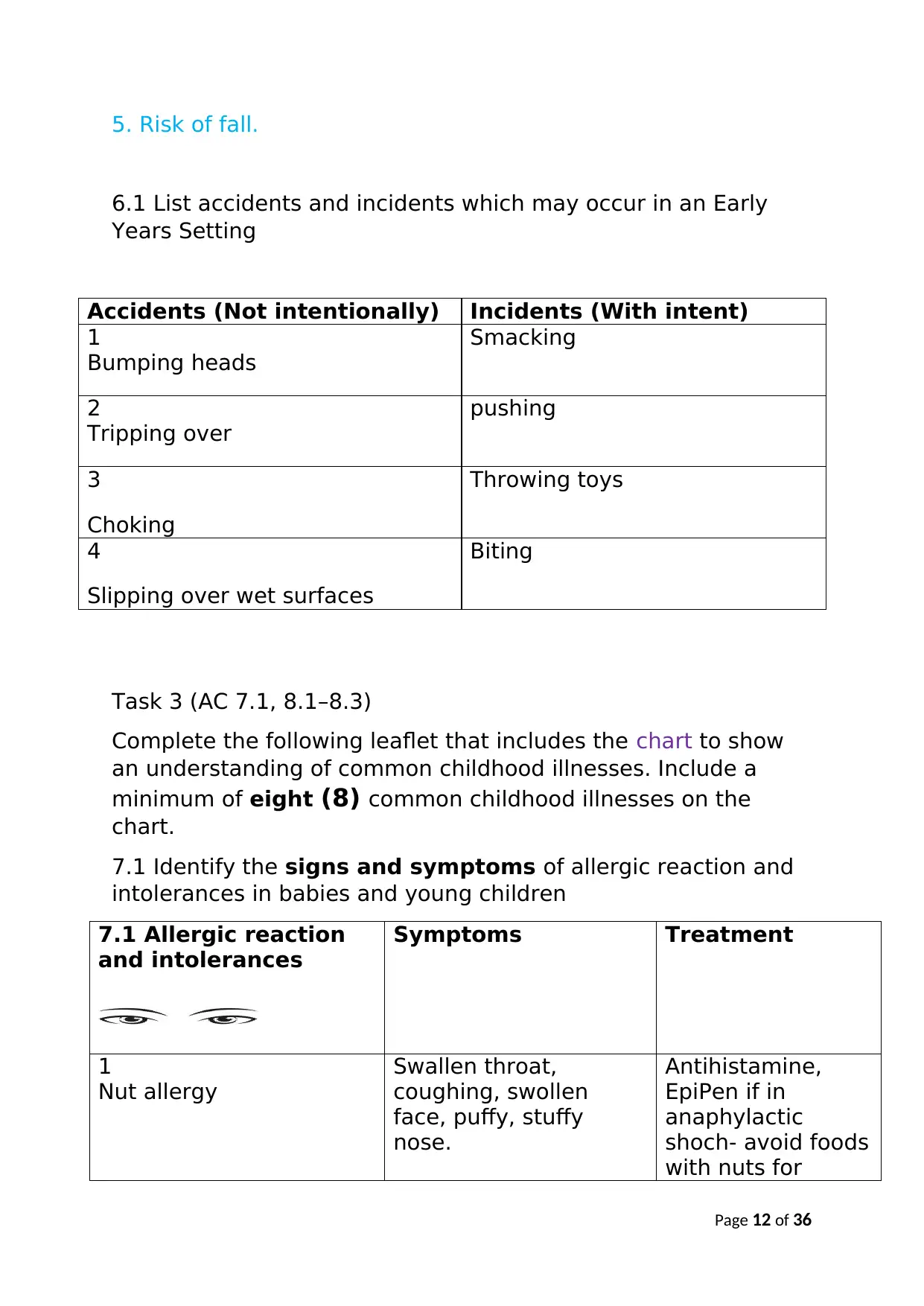
5. Risk of fall.
6.1 List accidents and incidents which may occur in an Early
Years Setting
Accidents (Not intentionally) Incidents (With intent)
1
Bumping heads
Smacking
2
Tripping over
pushing
3
Choking
Throwing toys
4
Slipping over wet surfaces
Biting
Task 3 (AC 7.1, 8.1–8.3)
Complete the following leaflet that includes the chart to show
an understanding of common childhood illnesses. Include a
minimum of eight (8) common childhood illnesses on the
chart.
7.1 Identify the signs and symptoms of allergic reaction and
intolerances in babies and young children
7.1 Allergic reaction
and intolerances
Symptoms Treatment
1
Nut allergy
Swallen throat,
coughing, swollen
face, puffy, stuffy
nose.
Antihistamine,
EpiPen if in
anaphylactic
shoch- avoid foods
with nuts for
Page 12 of 36
6.1 List accidents and incidents which may occur in an Early
Years Setting
Accidents (Not intentionally) Incidents (With intent)
1
Bumping heads
Smacking
2
Tripping over
pushing
3
Choking
Throwing toys
4
Slipping over wet surfaces
Biting
Task 3 (AC 7.1, 8.1–8.3)
Complete the following leaflet that includes the chart to show
an understanding of common childhood illnesses. Include a
minimum of eight (8) common childhood illnesses on the
chart.
7.1 Identify the signs and symptoms of allergic reaction and
intolerances in babies and young children
7.1 Allergic reaction
and intolerances
Symptoms Treatment
1
Nut allergy
Swallen throat,
coughing, swollen
face, puffy, stuffy
nose.
Antihistamine,
EpiPen if in
anaphylactic
shoch- avoid foods
with nuts for
Page 12 of 36
⊘ This is a preview!⊘
Do you want full access?
Subscribe today to unlock all pages.

Trusted by 1+ million students worldwide
1 out of 36
Related Documents
Your All-in-One AI-Powered Toolkit for Academic Success.
+13062052269
info@desklib.com
Available 24*7 on WhatsApp / Email
![[object Object]](/_next/static/media/star-bottom.7253800d.svg)
Unlock your academic potential
Copyright © 2020–2026 A2Z Services. All Rights Reserved. Developed and managed by ZUCOL.





